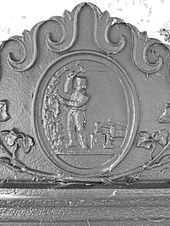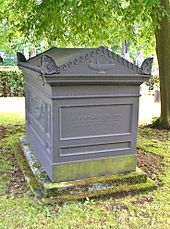Ludwig von Gienanth
Johann Ludwig Michael Gienanth , also Jean-Louis or Louis Gienanth , from 1817 Knight of Gienanth , from 1835 Baron von Gienanth (born October 15, 1767 in Hochstein , † December 13, 1848 in Schönau ) was a German industrialist in the iron industry.
Life
Gienanth came from a family who owned a hut (original spelling: Guinand ). He was a son of the Palatine hill council and lodge owner Johann Jakob Gienanth and Mary Magdalene, born Rettig. After a short visit to the school in Alsenbrück , he went to the Latin school in Grünstadt . He studied at the Hohen Kameral School in Kaiserslautern , at the University of Heidelberg and the Bergakademie Clausthal . He took over a small smelter over the Rhine from his father. In 1791 he leased the ironworks near Meiringen in the Bernese Oberland from the Great Council of Bern . His father had died in 1777 and his mother has managed the property ever since. After the death of the two older brothers, Ludwig Gienanth returned to the Palatinate in 1793 and took over the ironworks in Hochstein, Trippstadt and Altleiningen from his father's property . In 1800 he bought the ironworks in Eisenberg (Palatinate) and thus became the largest employer in the Palatinate.
On October 15, 1802, he was appointed Conseiller Général de Commerce d'Agriculture et des Arts by the French occupying forces . From 1802 he was a member of the department council and from 1805 he was special commissioner for road construction in the Donnersberg department .
After the Palatinate passed to Bavaria in 1816, Gienanth led the elections to the Palatinate District Administrator , to which he himself belonged. In 1817 he received the Knight's Cross of the Order of Merit of the Bavarian Crown and was raised to the nobility, since 1819 he was Imperial Councilor of the Crown of Bavaria . In 1833 the industrialist founded a company health insurance fund . In May 1835 he bought the smelter in Schönau and the Imsbach ore mine . On September 27, 1835, King Ludwig I granted him the hereditary Bavarian baron title along with a coat of arms.
Ludwig Gienanth was married to Sophie Katharina born in 1800. Stoeß (1783–1821) from Mannheim . The family lived in Hochstein. As male descendants, they had the sons August (1802–1829), Friedrich (1805–1842) and Carl (1818–1890), as well as the daughters Amalia ( ⚭ Government Director Friedrich von Neimans) and Juliane ( ⚭ Gustav Freiherr von Gemmingen- Hagenschieß) . When he was old, Ludwig moved to Schönau and devoted himself to the ironworks there, which he bequeathed to his two daughters. The community of Schönau granted him honorary citizenship.
For August von Gienanth, who died early and to whom he had given the Trippstadt business in 1822, his father had a classical cast iron tomb in the shape of a tumba built in Kaiserslautern , which is now in the main cemetery there. It was transferred from the old cemetery. In addition to an early Gienanthwerke emblem, it bears the inscription:
" You died, oh son, too early for me, too early for my own, who weep wistfully with me for you, the noble brother." But the reunion comforts us in a better life, where you transfigured, from those heights, we will float towards us. "
The second son, Friedrich, took over the management of the Eisenberger and Altleininger factories from 1823. The "Friedrich von Gienanth Landscape Park", which was built near Eisenberg between 1826 and 1834, still reminds of its creator, who also died young. He was married to Caroline von Stichaner, the daughter of the Palatinate District President Joseph von Stichaner .
In 1841, Ludwig von Gienanth handed over the management of his works to his youngest son Carl, who was the only surviving family owner who led the legacy of his forefathers into the future. He was married to Mathilde geb. von Horn (1822–1862), daughter of General Wilhelm von Horn (1784–1847), a nephew of Prince Carl Philipp von Wrede .
One of Ludwig von Gienanth's grandchildren was the explorer Richard von Neimans (1832-1858).
literature
- Kurt Baumann: Gienanth, Johann Michael Ludwig Ritter von, Freiherr von. In: New German Biography (NDB). Volume 6, Duncker & Humblot, Berlin 1964, ISBN 3-428-00187-7 , p. 372 f. ( Digitized version ).
- Alexandra Plettenberg: The Hohe-Kameral-Schule zu Lautern 1774–1784 , dissertation, Munich 1983, pp. 220–222.
- Edgar Fried: A man of old shot and grain , article on the 150th anniversary of death, in the Rheinpfalz , Ludwigshafen am Rhein, local edition Eisenberg, December 31, 1998.
Web links
- Gienanth Landscape Park, Eisenberg
- Ludwig von Gienanth in the parliamentary database at the House of Bavarian History
- History of the Gienanth Werke Eisenberg
Individual evidence
- ↑ Cast iron plaque at the former iron smelter in Winnweiler.
- ^ Government Gazette for the Kingdom of Bavaria , No. 14, Munich, April 30, 1836. [1]
- ↑ http://landschaftspark-von-gienanth.de/park.html .
| personal data | |
|---|---|
| SURNAME | Gienanth, Ludwig von |
| ALTERNATIVE NAMES | Gienanth, Johann Ludwig von; Gienanth, Jean-Louis; Gienanth, Louis; Gienanth, Ludwig |
| BRIEF DESCRIPTION | German industrialist in the iron industry |
| DATE OF BIRTH | October 15, 1767 |
| PLACE OF BIRTH | Hochstein |
| DATE OF DEATH | December 13, 1848 |
| Place of death | Schönau |



